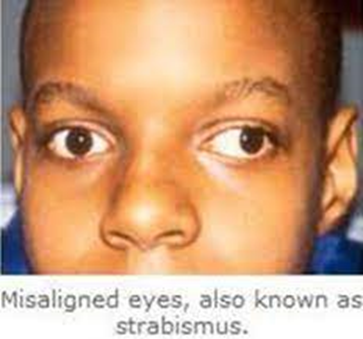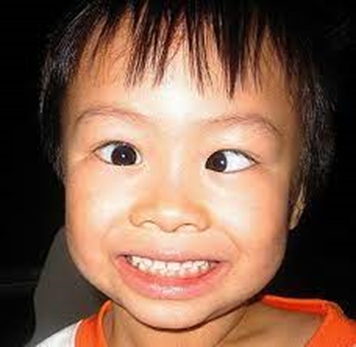Amblyopia or Lazy Eye
Amblyopia, also called lazy eye, is a disorder of
sight in which the brain fails to fully process input from one eye and over
time favors the other eye. It results in decreased vision in an eye that typically appears
normal in other aspects. Amblyopia is the most common cause of decreased
vision in a single eye among children and younger adults. The cause of
amblyopia can be any condition that interferes with focusing during early
childhood.
This can occur from poor alignment
of the eyes (strabismic), an eye being irregularly shaped such that focusing is difficult, one eye being more
nearsighted or farsighted than the other (refractive), or clouding of the
lens of an
eye (deprivational). After the underlying cause is addressed, vision is
not restored right away, as the mechanism also involves the
brain. Amblyopia can be difficult to detect, so vision testing is recommended for all children around the ages of
four to five.
Early detection improves treatment success.
Glasses may be all the treatment needed for some children. If this is not sufficient, treatments which
encourage or force the child to use the weaker eye are used.
This is done by either using
a patch or putting atropine in the stronger eye. Without treatment,
amblyopia typically persists. Treatment in adulthood is usually
much less effective.
Amblyopia begins by the age of five. In adults, the
disorder is estimated to affect 1–5% of the population. ]While treatment improves vision, it does not typically
restore it to normal in the affected eye. Amblyopia was first described in 1600s. The condition may
make people ineligible to be pilots or police officers. The word amblyopia is
from Greek ἀμβλύς amblys, meaning "blunt", and ὤψ ōps, meaning "sight".
Signs and symptoms
Many people with amblyopia, especially those who only
have a mild form, are not aware they have the condition until tested at older
ages, since the vision in their stronger eye is normal. People with amblyopia
typically have poor stereo vision, since it requires both eyes. They further may have, on
the affected eye, poor pattern recognition, poor visual acuity, and low sensitivity to contrast and motion.
Amblyopia is characterized by several functional
abnormalities in spatial vision, including reductions in visual acuity, contrast sensitivity function, and vernier acuity, as well as spatial distortion, abnormal spatial
interactions, and impaired contour detection. In addition, individuals with
amblyopia have binocular abnormalities such as impaired stereoacuity (stereoscopic acuity) and abnormal binocular summation. Also, central vision in amblyopes is
more crowded than central vision in normal observers.
These deficits are usually specific to the amblyopic eye.
Subclinical deficits of the "better" eye have also been demonstrated.
People with amblyopia also have problems of binocular vision such as limited stereoscopic depth perception and usually have difficulty seeing the
three-dimensional images in hidden stereoscopic displays suchas autostereograms. Perception of depth, from monocular cues such as size, perspective, and motion parallax remains normal.
Cause
Amblyopia has three main causes:
·
Strabismic: by strabismus (misaligned eyes)
·
Refractive: by anisometropia (difference of a certain degree of nearsightedness, farsightedness, or astigmatism), or by significant amount of equal refractive error in
both eyes
·
Deprivational: by deprivation of vision early in life by vision-obstructing
disorders such as congenital cataract
Strabismus
Strabismus, sometimes also incorrectly called lazy eye,
is a condition in which the eyes are misaligned. Strabismus usually results in normal vision in the
preferred sighting (or "fellow") eye (the eye that the person prefers
to use), but may cause abnormal vision in the deviating or strabismic eye due
to the difference between the images projecting to the brain from the two eyes. Adult-onset strabismus usually causes double
vision (diplopia), since the two eyes are not fixed on the same object. Recent
evidence points to a cause of infantile strabismus lying with the input to
the visual cortex.
Those with strabismic amblyopia tend to show ocular
motion deficits when reading, even when they use the nonamblyopic eye. In
particular, they tend to make more saccades per line than persons with normal stereo vision,
and to have a reduced reading speed, especially when reading a text with small font size.
Strabismic amblyopia is treated by clarifying the visual
image with glasses, or encouraging use of the amblyopic eye with an eyepatch over the dominant eye or pharmacologic
penalization of the better eye. Penalization usually consists of applying atropine drops to temporarily paralyze the accommodation
reflex, leading to the blurring of vision in the good eye. It also dilates
the pupil. This helps to prevent the bullying and teasing
associated with wearing a patch, although sometimes application of the eye
drops is challenging. The ocular alignment itself may be treated with surgical
or nonsurgical methods, depending on the type and severity of the strabismus.
Refractive
Refractive amblyopia may result from anisometropia (unequal refractive error between the two
eyes). Anisometropia exists when
there is a difference in the power between the two eyes. The eye which provides the
brain with a clearer image typically becomes the dominant eye. The image in the
other eye is blurred, which results in abnormal development of one half of the
visual system. Refractive amblyopia is usually less severe than strabismic
amblyopia and is commonly missed by primary care physicians because of its less dramatic appearance and lack of
obvious physical manifestation, such as with strabismus. Given that the
refractive correction of anisometropia by means of spectacles typically leads
to different image magnification for the two eyes, which may in turn prevent
binocular vision, a refractive correction using contact lenses is to be considered. Also pediatric refractive surgery is a treatment option, in particular if conventional
approaches have failed due to aniseikonia or lack of compliance or both.
Frequently, amblyopia is associated with a combination of
anisometropia and strabismus. In some cases, the vision between the eyes can
differ to the point where one eye has twice average vision while the other eye
is completely blind.
Deprivation and
occlusion
Deprivation amblyopia (amblyopia ex anopsia) results when
the ocular media become opaque, such as is the case with congenital cataract or corneal haziness. These opacities prevent adequate visual input from
reaching the eye, and disrupt development. If not treated in a timely fashion,
amblyopia may persist even after the cause of the opacity is removed.
Sometimes, drooping of the eyelid (ptosis) or some other problem causes the upper eyelid to
physically occlude a child's vision, which may cause amblyopia quickly. Occlusion
amblyopia may be a complication of a hemangioma that blocks some or all of the eye. Other possible
causes of deprivation and occlusion amblyopia include obstruction in the
vitreous and aphakia. Deprivation amblyopia accounts for less than 3% of
all individuals affected by amblyopia.
Pathophysiology
Amblyopia is a developmental problem in the brain, not any intrinsic, organic neurological problem in the eyeball (although organic problems) can lead to amblyopia which can continue to exist after the organic problem has resolved by medical intervention). The part of the brain receiving images from the affected eye is not stimulated properly and does not develop to its full visual potential. This has been confirmed by direct brain examination. David H. Hubel and Torsten Wiesel won the Nobel Prize in Physiology or Medicine in 1981 for their work in showing the extent of the damage to ocular dominance columns produced in kittens by sufficient visual deprivation during the so-called "critical period". The maximum "critical period" in humans is from birth to two years old.
Diagnosis
Amblyopia is diagnosed by identifying low visual acuity
in one or both eyes, out of proportion to the structural abnormality of the eye
and excluding other visual disorders as causes for the lowered visual acuity.
It can be defined as an interocular difference of two lines or more in acuity
(e.g. on Snellen chart) when the eye optics are maximally corrected. In young children,
visual acuity is difficult to measure and can be estimated by observing the reactions
of the patient when one eye is covered, including observing the patient's
ability to follow objects with one eye.
Stereotests like the Lang stereotest are not reliable exclusion tests for amblyopia. A
person who passes the Lang stereotest test is unlikely to have strabismic
amblyopia, but could nonetheless have refractive or deprivational amblyopia. Binocular retinal birefringence scanning may be able to identify, already in very young
children, amblyopia that is associated with strabismus, microstrabismus, or
reduced fixation accuracy. Diagnosis and treatment of amblyopia as early as
possible is necessary to keep the vision loss to a minimum. Screening for
amblyopia is recommended in all people between three and five years of age.
Treatment of strabismic or anisometropic amblyopia
consists of correcting the optical deficit (wearing the necessary spectacle
prescription) and often forcing use of the amblyopic eye, by patching the good
eye, or instilling topical atropine in the good eye, or both.
Atropine
appears to result in similar outcomes to patching. If there is overpatching or overpenalizing the good
eye when treating amblyopia, "reverse amblyopia" can result.
Eye patching
is usually done on a part-time schedule of about 4–6 hours a day. Treatment is
continued as long as vision improves. It is not worthwhile continuing to patch
for more than 6 months if no improvement continues.
Deprivation amblyopia is treated by removing the opacity
as soon as possible followed by patching or penalizing the good eye to
encourage the use of the amblyopic eye. The earlier the treatment is initiated, the easier
and faster the treatment is and the less psychologically damaging. Also, the
chance of achieving 20/20 vision is greater if treatment is initiated early.
One of the German public health insurance providers, Barmer, has changed its policy to cover,
as of 1 April 2014, the cost of software for amblyopic children whose condition
did not improve through patching. The app offers dedicated eye exercises that
the patient performs while wearing an eyepatch.
Older age
Treatment of individuals age 9 through to adulthood is
possible through applied perceptual learning. Tentative evidence
shows that perceptual training may be beneficial in adults.
Epidemiology
Amblyopia occurs in between 2 and 5% of the population in Western countries. In UK, 90% of visual health appointments in the child concern amblyopia.
Depending on the chosen criterion for diagnosis, between
1 and 4% of the children have amblyopia..
Research
A 2009 study widely reported in the popular press, has
suggested that repetitive transcranial magnetic stimulation may temporarily improve contrast sensitivity and
spatial resolution in the affected eye of adults with amblyopia. This approach
is still under development, and the results await verification by other
researchers. Comparable results may be achieved using different types of brain
stimulation, such as anodal transcranial
direct current stimulation.
A 2013 study concluded that converging evidence indicates
decorrelated binocular experience plays a pivotal role in the genesis of
amblyopia and the associated residual deficits. Another study of suggests
that playing a version of the popular game Tetris that is modified such that each eye sees separate
components of the game may also help to treat this condition in adults. ] Furthermore, the effects of this kind of therapy
may be further enhanced by noninvasive brain stimulation as shown by a recent study using anodal tDCS.
A 2014 Cochrane review sought to determine the
effectiveness of occlusion treatment on patients with sensory deprivation
amblyopia, but no trials were found eligible to be included in the
review. However, good outcomes from occlusion treatment for sensory
deprivation amblyopia likely rely on compliance with the treatment.
Jan Ricks Jennings
Senior Consultant
Senior Management Resources, LLC
412.913.0636 Cell
724.733.0509
Office
JanJenningsBlog.Blogspot.com





No comments:
Post a Comment